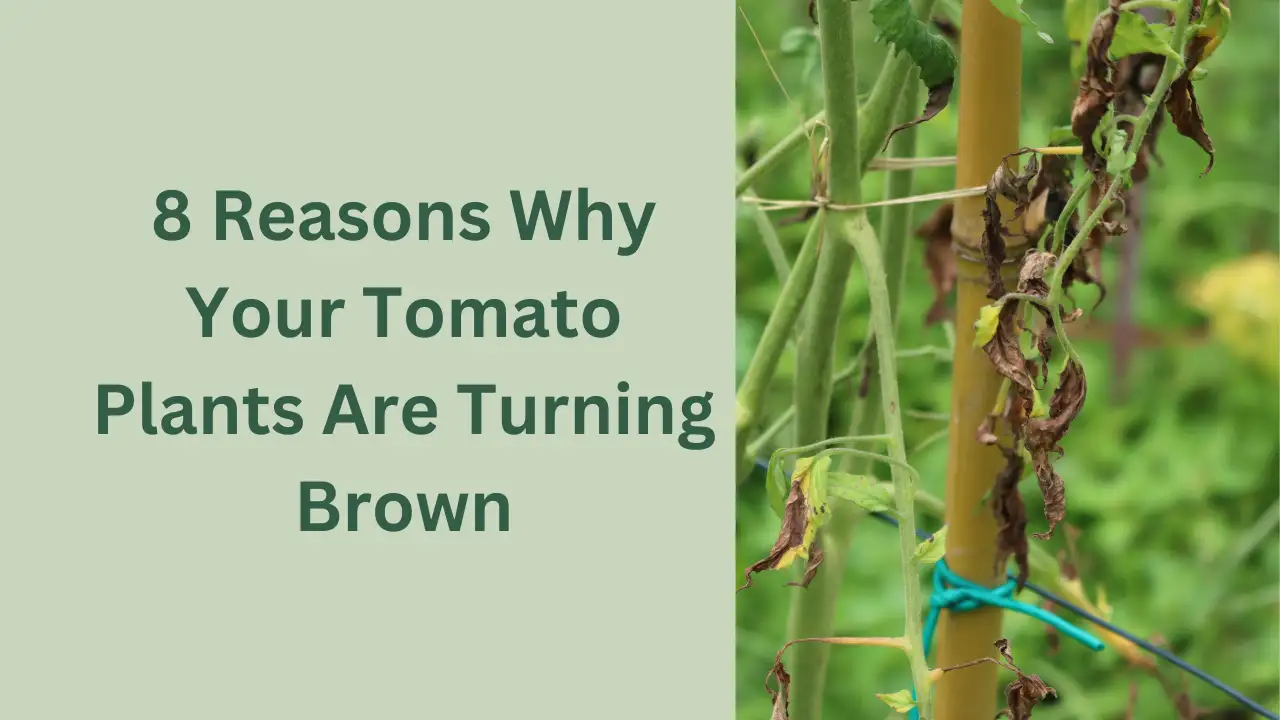It is very exciting to grow your own tomatoes in your garden. The cost of both growing tomatoes and maintaining delicious, juicy tomatoes is very low. It is also very easy, even for new gardeners, to grow.
Yes, tomatoes can be grown easily, but it involves many challenges while completing everything from growing to harvesting. It doesn’t matter if it’s a new or experienced tomato gardener; everyone faces many challenges with tomato plant problems. It might be a pest attack, infections or browning of leaves.
I have discussed the reasons responsible for the browning of tomato leaves. The browning of tomato leaves can result in wilting, immature fruit dropping and many other problems. Most of the issues can be easily fixed and controlled. So let’s jump into it!
1. Underwatering
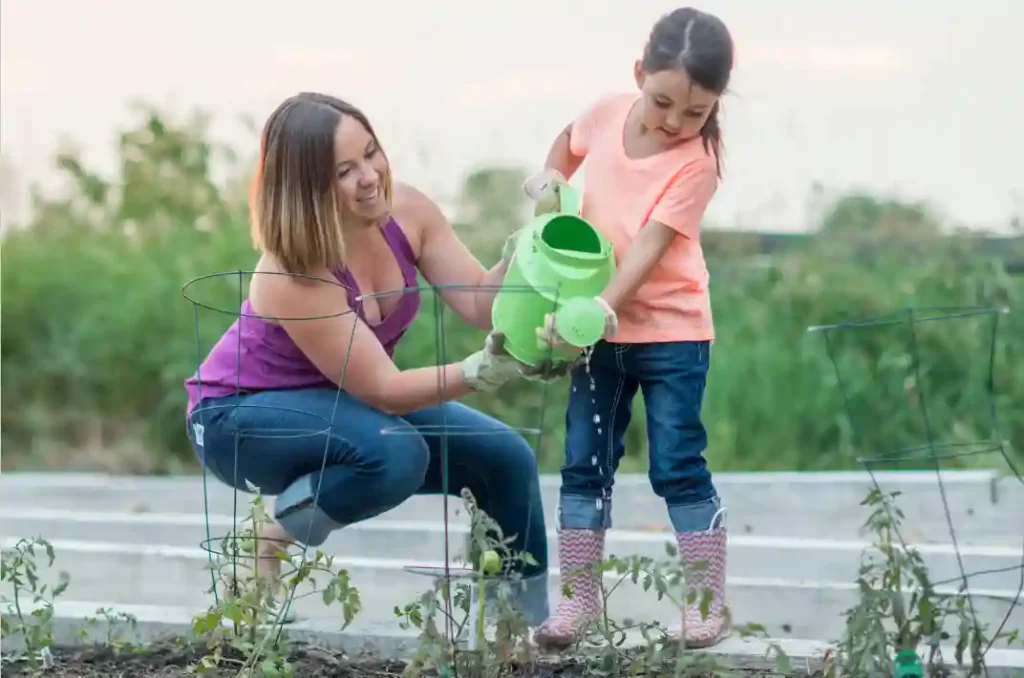
When the leaves of tomato plants look dry, and the border seems to be brownish, it may happen because of underwatering issues.
The initial problem for the browning of the leaves on tomato plants is because of wrong watering techniques and underwatering of the plants.
The tomato plant cannot tolerate it if left soaked in water but performs well if watered frequently and deeply.
Underwatering plants can lead to many problems like the browning of leaves, wilting and defoliation. The plant can suffer blossom drop issues also, leading to no fruit production, and if any tomatoes are produced, they might be dry and hard.
How To Fix
Browning of tomato plant leaves can be controlled and fixed by following the below tips:
- Water the plants by adopting the correct technique.
- Water the tomato plants slowly, deeply and consistently. But this should be made a regular practice even if your plant is already healthy and strong.
- The root system of tomato plants goes deep down up to 5 feet. This is why it is always advised to deeply water the plant so that water can reach the end of the root—shallow watering results in water stress and browning of leaves.
- Overhead irrigation should be strictly avoided as it can result in a spattering of water and can attract fungal infections and tomato plant diseases. So make a habit of watering your tomato plants in the soil around the base of the plant.
- The best time to water your tomato plants is in the cool morning because rare water evaporation happens, and plants can absorb more water.
- Know the right moment to water the plant. If the soil is still wet, do not water them; otherwise, it may become soggy and results in root rot, wilting and browning of leaves.
2. Blossom End Rot
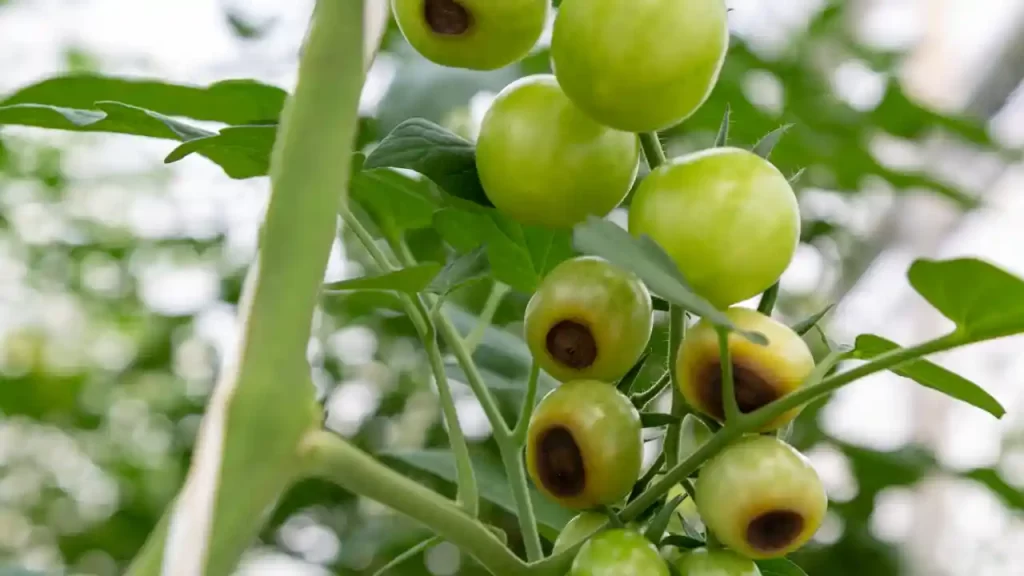
When deep brown leathery sunken areas on the tomato fruits appear, your tomato has already caught blossom end rot. Blossom end rot can seem like destroying your plant, but it can be easily cured if properly managed.
The rot is commonly spotted at the bottom of the tomatoes, opposite the stem, and seems like watery brown lesions. If not taken care of, the affected area increases in diameter, and the spot turns dark brown and later becomes black. And the impacted area flattens as it spreads.
The worst part is that you could only spot the blossom end rot when the tomatoes are almost half matured. And when it is spotted, it should be removed and disposed of soon.
Some of the reasons for blossom end rot are calcium deficiency, excessive watering, inconsistency in watering the tomato plants, or you might be facing soil issues.
Calcium deficiency may arise because of certain reasons. The plant might not be able to absorb calcium even if the soil is rich in calcium. The not ideal pH level of soil, high content of nitrogen, and inconsistency in soil temperature impact calcium absorption in tomato plants. Please be careful regarding all these issues to avoid problems with your tomato plants.
How To Fix
If your tomatoes have already caught blossom end rot, you can follow below mentioned tips to prevent and control blossom end rot.
- Do a soil test to trace any deficiency or other issues and act accordingly to amend the soil.
- Tomatoes love to grow in slightly acidic soil, and if your soil test result reflects a more alkaline pH level, you can mix compost and adjust the soil’s pH level. And if the soil is acidic more than needed, use lime to reverse the pH of the soil.
- You must adjust or change the fertilizer if the soil contains extra nitrogen. Excess nitrogen content in the plant can make it bushy and inefficient in absorbing calcium. High nitrogen content produces leggy and bushy plants and only small-sized tomatoes. Correct and suitable fertilizer is necessary not only to prevent blossom end rot but also to maintain the overall health of your plant. Thus it is always suggested to opt for fertilizer which contains low nitrogen and high phosphorus to prevent calcium absorption issues and help your plant to perform well.
- Soil temperature also fluctuates; sometimes, it becomes too cold or hot, impacting the nutrient absorption of the plants. Mulching straw or dry leaves is the best way to regulate the temperature and maintain the moisture level in the soil.
3. Spider Mites
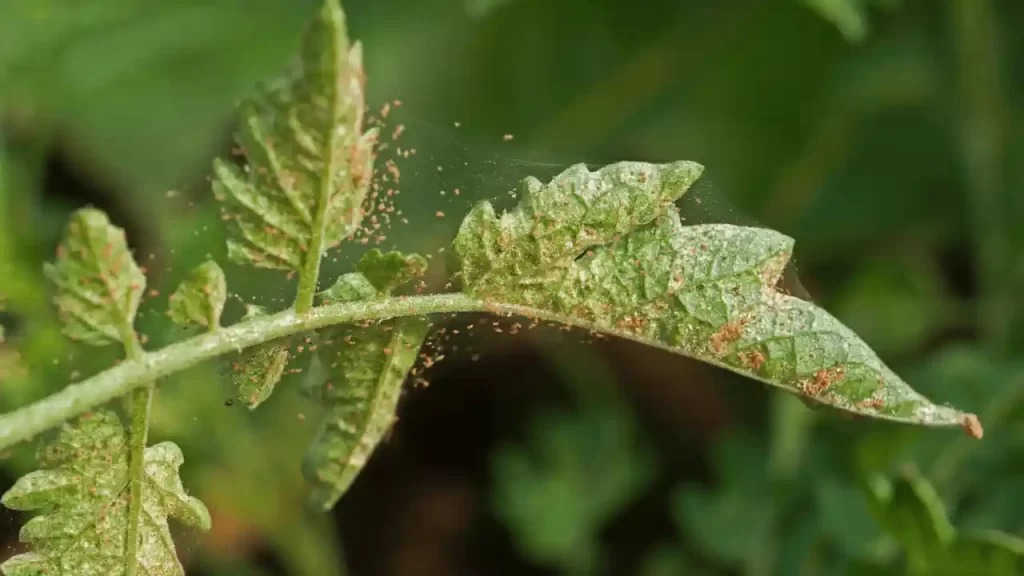
Spider mites are small aphids commonly found in tomato gardens and can easily and rapidly damage plants. They are also known as two-spotted mites and eat the cells of the plants and leave tiny brown spots on the tomato plant leaves.
Spider mites prefer to come in large groups and infect the tomato leaves on their underside areas. They extract the leaves’ sap which results in cell damage and eventually leads to the death of the cells. Later a brown spot on the leaves is formed.
Due to these strange activities of spider mites, leaves turn reddish brown or sometimes become brown edges yellowish and dry out. As a result, the impacted leaves die and drop from the plant. If spider mites are not taken care of, they can destroy all the plant leaves and eventually, the whole plant can die soon.
How To Fix
The little Spider mites are quite attracted to dry and hot weather. With the change in weather and climate, spider mites can go away.
Ensure to adopt the right technique for watering your tomato plants. It maintains the plant’s good health and never attracts spider mites toward the plants. The application of good parasitic pests also prevents the entry of spider mites into your garden.
There are several ways to remove the spider mites and protect your plant from getting damaged if they have already settled on your tomato plants.
You can apply neem oil to remove small infestations of spider mites. You can also apply insecticidal soaps. It can destroy spider mites and their larvae and cease their infestations.
Even after following all the steps, If webbing does not stop and your plant is getting weak every day, it is time to uproot the plant and discard it immediately. Remember not to use such plants as mulch.
4. Bacterial Leaf Spot
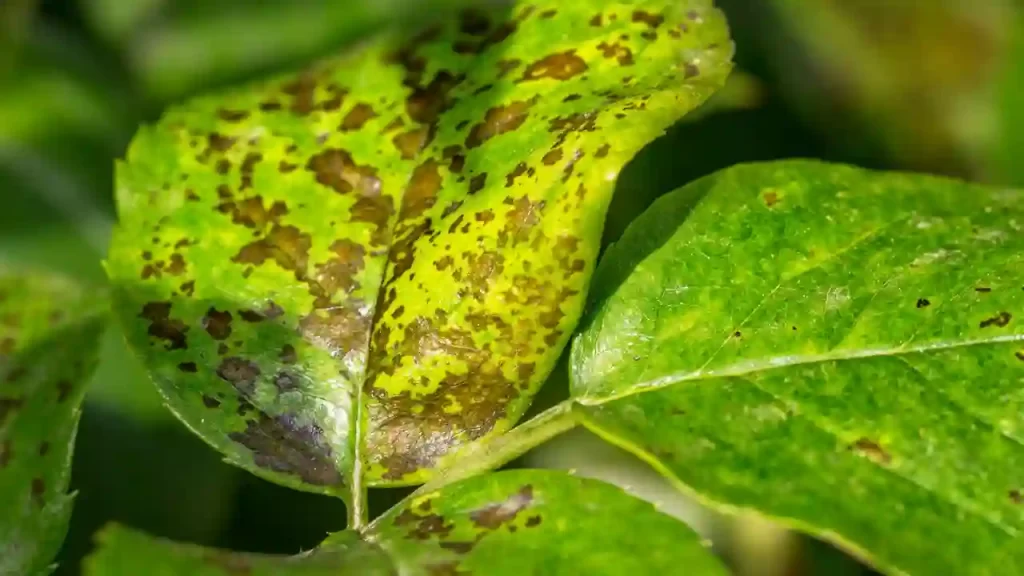
Another reason for the browning of tomato leaves is bacterial leaf spots. Mainly leaves are impacted due to the disease, but other parts of the plants, like stems and fruits, also remain at high risk because of the spread of such disease. It is caused by a bacteria named Xanthomonas, and it is not only harmful to your single tomato plant but can also rapidly spread to the whole garden and impact all other plants badly.
The infected leaves develop brown, water-soaked brown spots. If bacterial leaf spots remain unattended, they can spread to the whole plant, including its fruits and form round brown dots all over the tomato plant’s leaves. Sometimes, the leaves of tomato plants turn yellow and begin to drop from the plants, which can put the plants at high risk of sunscald and defoliation.
How To Fix
Sadly, the plant infected due to bacterial leaf spots cannot be cured at all. As and when the disease is spotted on your plant, remove and discard the plant soon to save your healthy plants and stop the further spread of the disease.
As the infected plants cannot be cured, prevention is the only measure to protect the plants from such diseases. Luckily, the prevention process is damn simple.
The first step towards preventing such disease is choosing and transplanting tomato seeds free from any bacteria. Closely monitor your plant for any symptoms of the disease while the plantation process and preserve the seeds of healthy tomato plants to avoid any complications in future.
Adopting the right method of watering can prevent bacterial leaf spots.
Avoid overhead irrigation to prevent attracting the plant from infections and diseases. Ensure to water deeply in the soil around the base of the plants.
Bacterial leaf spots are volatile in nature and spread quickly. It can simply remain in the soil and on the debris of the plants. Maintaining good hygiene in the plants is quite important to prevent them. Sanitize the gardening tools and equipment before and after use. Always keep a close look to check the presence of any weeds and if spotted, remove them immediately. Also, remove plant debris from the garden and maintain clean garden beds.
Crop rotation is another good practice to prevent bacterial leaf spots and maintain the overall health of your plants.
5. Early Blight
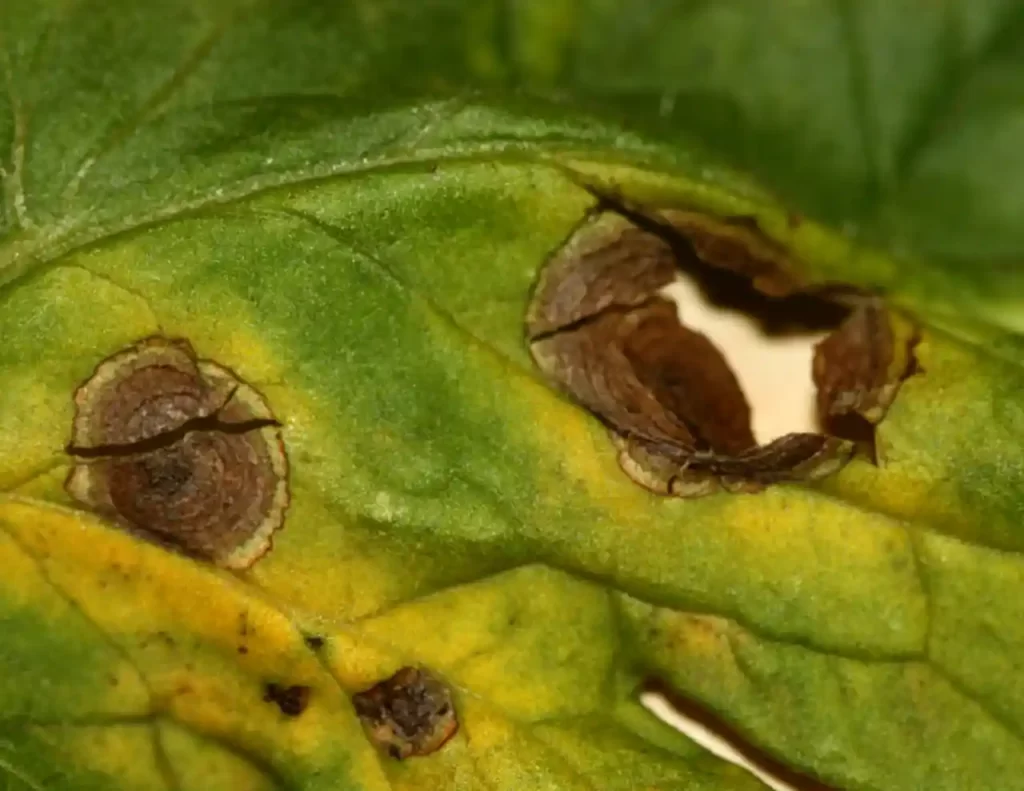
Early blight, a fungal disease caused by Alternaria solani, impacts tomato plants and results in causing brown spots all over the plant. Early blights are very dangerous for tomato plants and can destroy your garden. But if you are lucky enough to spot them on time, they can be cured, and all your crops can be saved.
The bacterial infection is spread by wind and infects the plant slowly. The leaves, which are impacted due to early blight, form a light brown spot of half an inch. The initial symptoms of early blight are quite similar to bacterial leaf spots, but early blight is a totally different disease.
With the spread of this fungal disease, the spot enlarges and becomes darker and tissue around the spots starts turning yellow and eventually turns brown. If left untreated, the infected leaves fall, and other parts of the plant, including the stem and fruits, also get infected.
How to Fix
Early blight is a disease that can destroy your tomato plants, including other plants in the garden. Fortunately, it can be easily cured if spotted on time.
Make a habit of monitoring the leaves of your tomato plants, and it becomes easier to catch diseases, pests or infections, if any, on your tomato plants. Early blight Infected leaves should be removed and discarded as and when spotted. Copper-based fungicides work best to remove the early blight from tomato plants.
Like all other infections and diseases, prevention is easier than curing it. Early blight can overwinter the soil and debris near your plants. Crop rotation is one of the effective measures to prevent early blight. Correct watering techniques and maintaining hygiene also help to prevent the disease.
Mulching is also one of the best options to prevent the disease, as water splashing on the leaves is controlled, and weeds are not attracted.
Supporting your tomato plants with trellis, cages, or stakes reduces the risk of such disease. Leggy growth and direct contact of plants with the ground are prevented, and air circulation is improved.
It is also advised to choose various tomato plants resistant varieties that are resilient to blights.
6. Late Blight
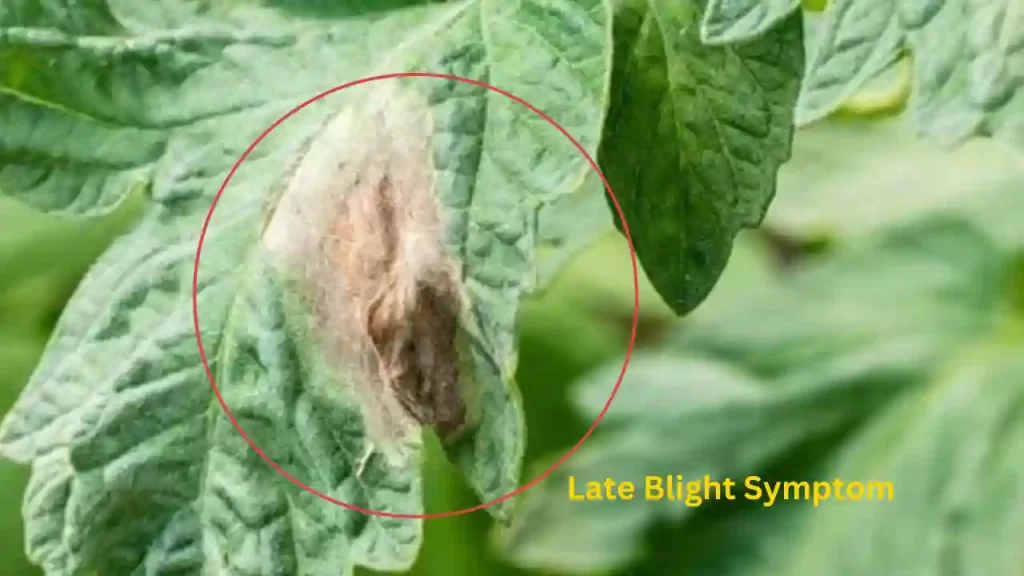
Some gardeners generally misunderstand the late blight with early blight. Both are fungal diseases that impact nightshade family plants. And the plant shows the same symptoms when affected due to such diseases. But both diseases are different from one another.
Late blight is caused by a fungal Pathogen called Phytophthora infestans. Late blight spreads faster, which makes it different from early blight. It can infect many plants at once, and plants start showing symptoms in only a few days. Later brown spots are developed rapidly on all the parts of the tomato plants.
The leaves of tomato plants develop pale green water-soaked lesions which turn dark brown and can spread to the whole part of the plants. Lastly, these spots turn black. White Fuzzy mold is also developed underneath the leaves when the climate is highly humid.
Due to Late Blight, stems older leaves of tomato plants develop dark brown spots with rounded edges. The further spread of infection destroys the whole stem and vine. Even a huge part of the fruits develop circular, leathery dark brown spots. White Fuzzy mold can also be formed in extremely humid conditions on the fruits.
How To Fix
Prevention is the only measure to save your tomato plants from destructive late blight, as it cannot be cured. The plants impacted due to late blight should be uprooted and disposed of soon and should never be used as mulch or compost to reduce the further spread of the disease in your garden.
The best way to prevent the risk of late blight is crop rotation, best watering techniques, and maintaining gardening hygiene. You can also plant tomatoes of a blight-resistant variety, mulch around the plant base and support your tomato plants with stakes, trellis or cages.
7. Canker

Canker is another severe disease that can even destroy your hard-grown tomato plant in the blink of an eye. Canker is caused by a fungus called Clavibacter michidanensis, and the disease can destroy any tomato plants rapidly.
Leaves caught in the clutches of bacterial canker form blisters like white-colored lesions and turn into light brown streaks, which later turn into large brown patches, and the leaves’ corner becomes crispy. Generally, yellow linings are seen in the browned areas of the leaves. If left unattended, the leaves’ veins sink and turn dark brown. All the affected leaves wilt and curl in upward directions and finally die.
Along with leaves, it also impacts the stems of tomato plants. The long brown strips developed on the branches become rough and cracked. When cankers impact stems, water flow is interrupted, and proper nutrients are not delivered to the plant.
Cankers do not leave even fruits. I already discussed that when stems get impacted, the nutrients do not reach any part of the plant. Thus, fruits also remain without proper nutrients and form sunken white lesions that later turn light brown. The fruits infected due to cankers may develop an odor.
How To Fix
Once your plant catches canker, it cannot be cured at all. Yes, you heard it correctly; sadly, this disease cannot be cured. If you trace any infected plant, instantly remove it from the roots and discard it. Avoid mulching such affected plants, to reduce the risk of spreading the disease. Monitor all the plants in your garden to spot any such disease and take action accordingly.
If the disease is not curable, it is better to adopt preventive measures to restrict the entry of such hazardous diseases into your garden. Like other diseases discussed above, cankers develop in the same situations and environment.
Search for a resilient and disease-free variety of tomato seeds or plants before planting. Inspect the plant properly before bringing it in. Ensure to purchase it from trusted stores only.
After planting, always inspect the plant to check for any disease or infection. And if detected, remove the plant soon to reduce the risk of further spread of disease in your garden.
Always maintain good gardening hygiene, mulch your plant, adopt correct watering techniques and keep your your plants healthy garden safe from cankers and many other diseases. Crop rotation is also an excellent option to reduce the risk and control cankers in your garden.
8. Verticillium Wilt

Another destructive disease which can destroy your tomato plants rapidly is verticillium Wilt. It is hazardous for tomato plants and a wide range of plants, trees and even ornamentals. A fungus named Verticillium dahliae is responsible for such a destructive disease.
It impacts different plants in different ways. When it comes to tomato plants, the most common sign is the browning of the leaves and stems of the plant.
The first target of Verticillium Wilt is older, and lower leaves of tomato plants and the affected leaves turn their color to yellow and later, dark brown patches on the leaves are developed.
Finally, the leaves of tomato spotted wilt virus will wilt and die. Brown strips with patches are formed on the stems, leading to the whole plant’s death.
Verticillium wilt can spread rapidly to the whole garden and destroy your precious plants if not taken care of timely.
How To Fix
Like many other diseases, there is no treatment for verticillium wilt too. Infected plants should be rooted out completely from the ground and discarded, and never mistaken to use this as mulch.
But the best part is, it can be easily prevented if a few things are ensured.
- Plant a verticillium wilt resilient variety.
- Mulch on the base of the plant.
- Maintain good gardening hygiene.
- Adopt good watering methods and avoid overhead irrigation; rather, use soaker hoses and water at the base of the plants.
If all the points mentioned above are kept in practice, your plant will be free from many destructive diseases, including verticillium wilt.
Summary
Any gardener can come across the issue of browning tomato leaves, stems or fruits.
Some diseases can be cured, while some can be only prevented and do not have any curing means. Thus, it is always advisable to adopt measures which can avoid the risk of diseases, as many of them are hazardous to the overall health of your tomato plants. You can follow the methods discussed in the article and save your tomato garden from a devastating disease. Ensure to adopt a correct watering method, mulch around the base of your plant, maintain good airflow, support your plant, choose disease resilient variety of tomatoes and maintain good gardening hygiene. All these practices would never allow any disease to attack your precious tomato plants, and you can enjoy your healthy and delicious tomatoes all year.
Frequently Asked Questions
Is it OK to eat tomatoes with brown spots?
Yes, it is OK to eat tomatoes with brown spots. However, it’s important to remember that these spots are likely a sign that the tomato has gone slightly overripe and may not have the same flavor or texture as a ripe tomato. If the brown spot is only on the skin of the tomato, it is safe to eat the tomato as long as the spot does not appear moldy or slimy. If the brown spots are inside the tomato, it may be best to discard it.
Why are my tomatoes turning brown?
Browning of tomatoes is usually caused by environmental stress, such as not enough water, incorrect temperature, or too much sunlight. Improper watering can cause the tomato plants to wilt and the fruit to turn brown on its stem end. If temperatures become too hot while they are still green, the tomatoes may begin to sunburn and turn brown. If the tomatoes are exposed to too much direct sunlight, this can also cause brown spots and discoloration.
Should I remove the brown leaves from the tomato plant?
Removing brown leaves from a tomato plant is generally unnecessary, as tomatoes are fairly hardy. In most cases, they can deal with minor leaf discoloration on their own and will benefit from leaving the brown leaves in place. The brown leaves may indicate nutrient deficiencies or other issues, but they often occur naturally as part of the plant’s life cycle.
